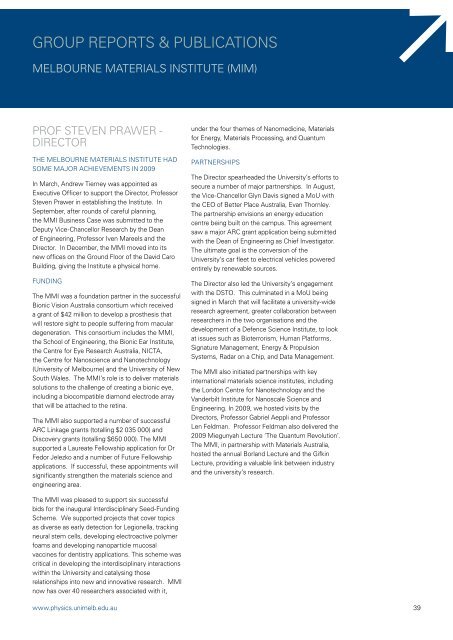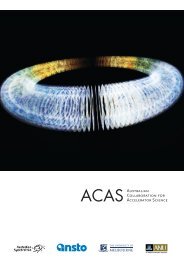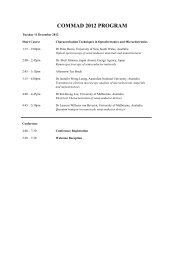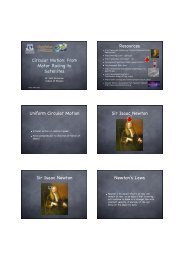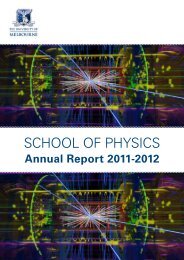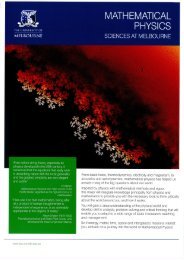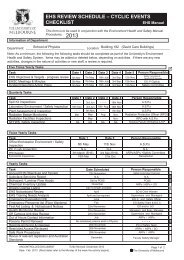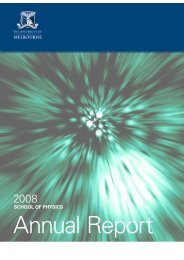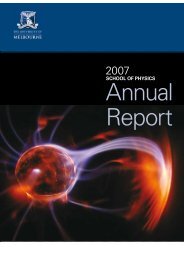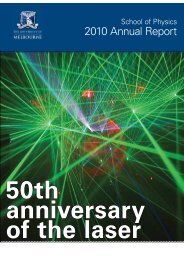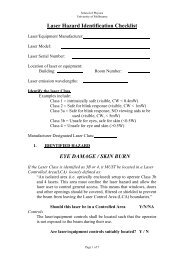Annual Report 2009.pdf - School of Physics - University of Melbourne
Annual Report 2009.pdf - School of Physics - University of Melbourne
Annual Report 2009.pdf - School of Physics - University of Melbourne
- No tags were found...
You also want an ePaper? Increase the reach of your titles
YUMPU automatically turns print PDFs into web optimized ePapers that Google loves.
group reports & publicationsMELBOURNE MATERIALS INSTITUTE (mim)pr<strong>of</strong> steven prawer -directorThe <strong>Melbourne</strong> Materials Institute hadsome major achievements in 2009In March, Andrew Tierney was appointed asExecutive Officer to support the Director, Pr<strong>of</strong>essorSteven Prawer in establishing the Institute. InSeptember, after rounds <strong>of</strong> careful planning,the MMI Business Case was submitted to theDeputy Vice-Chancellor Research by the Dean<strong>of</strong> Engineering, Pr<strong>of</strong>essor Iven Mareels and theDirector. In December, the MMI moved into itsnew <strong>of</strong>fices on the Ground Floor <strong>of</strong> the David CaroBuilding, giving the Institute a physical home.FundingThe MMI was a foundation partner in the successfulBionic Vision Australia consortium which receiveda grant <strong>of</strong> $42 million to develop a prosthesis thatwill restore sight to people suffering from maculardegeneration. This consortium includes the MMI,the <strong>School</strong> <strong>of</strong> Engineering, the Bionic Ear Institute,the Centre for Eye Research Australia, NICTA,the Centre for Nanoscience and Nanotechnology(<strong>University</strong> <strong>of</strong> <strong>Melbourne</strong>) and the <strong>University</strong> <strong>of</strong> NewSouth Wales. The MMI’s role is to deliver materialssolutions to the challenge <strong>of</strong> creating a bionic eye,including a biocompatible diamond electrode arraythat will be attached to the retina.The MMI also supported a number <strong>of</strong> successfulARC Linkage grants (totalling $2 035 000) andDiscovery grants (totalling $650 000). The MMIsupported a Laureate Fellowship application for DrFedor Jelezko and a number <strong>of</strong> Future Fellowshipapplications. If successful, these appointments willsignificantly strengthen the materials science andengineering area.under the four themes <strong>of</strong> Nanomedicine, Materialsfor Energy, Materials Processing, and QuantumTechnologies.PartnershipsThe Director spearheaded the <strong>University</strong>’s efforts tosecure a number <strong>of</strong> major partnerships. In August,the Vice-Chancellor Glyn Davis signed a MoU withthe CEO <strong>of</strong> Better Place Australia, Evan Thornley.The partnership envisions an energy educationcentre being built on the campus. This agreementsaw a major ARC grant application being submittedwith the Dean <strong>of</strong> Engineering as Chief Investigator.The ultimate goal is the conversion <strong>of</strong> the<strong>University</strong>’s car fleet to electrical vehicles poweredentirely by renewable sources.The Director also led the <strong>University</strong>’s engagementwith the DSTO. This culminated in a MoU beingsigned in March that will facilitate a university-wideresearch agreement, greater collaboration betweenresearchers in the two organisations and thedevelopment <strong>of</strong> a Defence Science Institute, to lookat issues such as Bioterrorism, Human Platforms,Signature Management, Energy & PropulsionSystems, Radar on a Chip, and Data Management.The MMI also initiated partnerships with keyinternational materials science institutes, includingthe London Centre for Nanotechnology and theVanderbilt Institute for Nanoscale Science andEngineering. In 2009, we hosted visits by theDirectors, Pr<strong>of</strong>essor Gabriel Aeppli and Pr<strong>of</strong>essorLen Feldman. Pr<strong>of</strong>essor Feldman also delivered the2009 Miegunyah Lecture ‘The Quantum Revolution’.The MMI, in partnership with Materials Australia,hosted the annual Borland Lecture and the GifkinLecture, providing a valuable link between industryand the university’s research.The MMI was pleased to support six successfulbids for the inaugural Interdisciplinary Seed-FundingScheme. We supported projects that cover topicsas diverse as early detection for Legionella, trackingneural stem cells, developing electroactive polymerfoams and developing nanoparticle mucosalvaccines for dentistry applications. This scheme wascritical in developing the interdisciplinary interactionswithin the <strong>University</strong> and catalysing thoserelationships into new and innovative research. MMInow has over 40 researchers associated with it,www.physics.unimelb.edu.au 39


